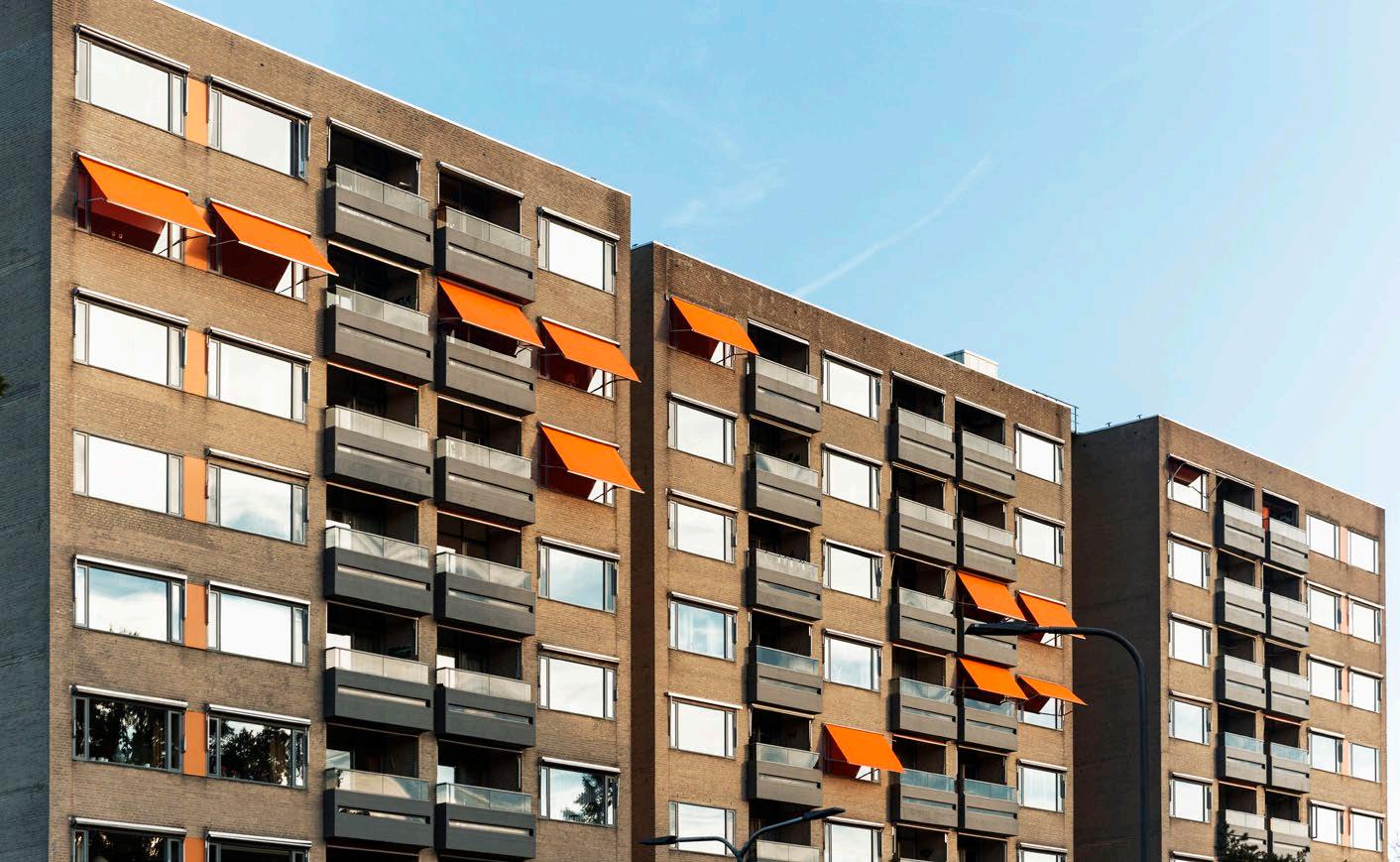
14 minute read
Evidence

EVIDENCE update
The latest research and analysis – in plain English
Issue 30 | May 2021
In this issue:
12 Welcome 12 Going Dutch: Agreements to raise performance and legitimacy 13 Free to view resources 14 The UK’s housing expenditure plans 16 Bringing Ireland’s housing stock up to standard 16 Northern Ireland Housing Executive: A two-part future? 17 Inbetweener generation faces stark choices
Welcome
The UK is reaching a better place in tackling the pandemic, but how are we faring on housing issues?
In this edition we take a look at the UK’s housing expenditure plans. In an excerpt from this year’s UK Housing Review, John Perry says Covid-19 has affected housing investment for years to come. And that’s at a time when the need to decarbonise the stock is becoming ever more urgent.
We take a look at housing issues around Europe, too. Sweden’s young people face serious difficulties in accessing any type of independent housing, new research finds. In Ireland there are moves to quantify the need to upgrade the housing stock. That country has some of the newest housing in Europe but that still leaves many homes with dangerous hazards. In the Netherlands, tenant organisations, local authorities and housing associations have been working jointly on performance agreements. Can tenants take their place at the table to influence what happens in their localities?
And finally, there are moves to settle the future of the Northern Ireland Housing Executive. The latest plans involve splitting the current organisation in two. But there will be big challenges in creating the new organisations necessary to both maintain the stock and create new housing.
We hope you find this edition of Evidence interesting and thought provoking. We’re always on the lookout for news of housing research projects so do get in touch if you have findings to share.
Janis Bright Editor, Evidence
A new paper examines the development of local performance agreements in social housing in the Netherlands.
Legislation from 2015 has required tripartite performance agreements between housing associations, local councils and tenant organisations. The idea was to boost tenant power and develop accountability in the sector toward local goals. The performance agreements can last from one to three years and must be renewed very regularly.
Under the legislation, housing associations must focus on their primary task of providing affordable housing for people on low incomes, with forprofit organisations providing for higher income groups. In the Netherlands, municipalities (local

councils) are funders of social housing, and performance agreements allow for financial rewards. Penalties can also be applied in the form of withdrawal of funding.
The performance agreements are intended to encourage development of local social housing policies and shared goals. But the paper finds that unequal relationships of skills and power can make this difficult. Tenant organisations in particular report that they find it difficult to play a full role in the decision making because they are voluntary and may lack time and skills, whereas the housing associations send professionals. Nevertheless, the number of agreements signed by tenant organisations has risen sharply.
For housing associations, the locally-based nature of the agreements can bring difficulties. Many operate in a number of local authority areas, and must make their investment decisions according to business needs. But this can cut across what the authorities and tenants want. In addition, local councils cannot simply demand what they want, as housing associations are independent bodies. So the relationship must be nuanced.
The writers found that of all the potential advantages and pitfalls, a cooperative relationship among the three stakeholders is the most important factor for success. Agreements in smaller local authority areas fared best, they found. However, many of those involved are calling for multi-year agreements as the process of annual renewal is too intensive.
Performance agreements to ensure societal legitimacy in the social housing sector; an embedded case study of implementation in the Netherlands, S G J Plettenburg, T Hoppe, H M H van der Heijden & M G Elsinga, Journal of Housing and the Built Environment https://bit.ly/2QhYldp
Free to view resources
Academic publishers Emerald are offering free to access resources on mental health, social inclusion and loneliness in these times of Covid-19. The content includes papers, blogs, videos and podcasts.
There’s a paper on understanding the psychological drivers of loneliness among older people, a video on ‘cabin fever’ and surviving lockdown, and another one on employees’ mental health, among various items on the website.

The UK’s housing expenditure plans
As well as disrupting housebuilding over the course of last year, the Covid-19 pandemic also affected housing investment plans for future years, writes John Perry in this extract from the latest UK Housing Review.
Responses to the pandemic may have been influential in the Westminster government’s decision to make a modest increase in investment from 2021/22 onwards, while they certainly delayed investment decisions in Scotland, Wales and Northern Ireland because of uncertainty about future levels of resources that the devolved governments would receive from Whitehall. Hopes of a ‘green recovery’ or of affordable housing investment being a tool to boost the economy were only partially fulfilled, despite representations that the social sector should have a lead role in the government’s decarbonisation drive.
Factors affecting social housing investment across the UK
During April-September 2020 at least 7,600 fewer affordable homes were built than would have been expected by comparison with the previous year.
While in England the Johnson government’s increased programme gives fresh priority to low-cost homeownership, in the other three administrations it seems likely that the focus on delivering social rented homes will continue.
There will be hangover effects from the pandemic at least into 2021/22, making any judgements about progress harder to reach than in normal conditions. The various targets set for housebuilding and for new affordable housing investment have been affected in several different ways. First came disruptions to construction activity when work stopped on site or proceeded more slowly; repairs backlogs also developed. Second, a near-halt in housing market activity hit sales of open-market and low-cost homeownership units, reducing the cross-subsidy available for rented housing. In England, for example, by the end of September there were just over 10,000 unsold properties, slightly fewer than in the previous quarter but with more than half of these standing unsold for at least six months.1
More broadly, a third factor has been the effects on landlords’ income of increased rent arrears, on which there are conflicting reports. HouseMark’s forecast is that social sector arrears could be onethird higher across the UK by the end of 2020/21 than they were at the start of the pandemic. Yet local authorities in England are forecasting arrears of less than 2% of their rent roll, while in Scotland council arrears exceed 8%, around twice as high as those for Scottish associations.2 Local authority housing revenue accounts appear to be robust compared with the critical state of many councils’ general funds, but there are concerns about knock-on effects if extra costs are pushed onto HRAs, and more widely that councillors might become extra cautious about making housing investment plans.
Fourth, rent levels are constrained by tenants’ reduced ability to pay, while many landlords also have higher management costs from providing extra support to tenants during the pandemic. In both England and Wales rent levels are fixed against CPI inflation for a further four years. In Scotland rent increases have typically exceeded inflation, but there are indications that social landlords might exercise restraint in 2021/22. In Northern Ireland, the Housing Executive’s rent levels remain pegged at low levels.
Yet despite these constraints, social landlords are taking on more debt. Social housing providers in England are planning “a historically high level” of new debt over the next five years according to the Regulator of Social Housing, which it said is “underpinned by assumed continued low interest rates in forecasts”. While for the time being rates seem set to stay low, this is by no means certain in the medium to longer term.
Apart from pressure to deliver new-build programmes, all landlords face the high costs of decarbonising their stock over the next 30 years, and shorter-term pressures to tackle building safety issues, with some of the landlords most affected also being those expected to contribute strongly to new build targets. Costs of construction and of land are also increasing in real terms, with the impact of Brexit on these and other cost factors still uncertain. In England, additional uncertainty has been created by proposed changes to the planning system and by the effects of new conditions on government grant (see below).
In summary, while there may be hopes that
social housing investment will increase across the UK from April 2021, backed by modest increases in grant programmes, social landlords face more than the usual level of constraints and countervailing pressures in aiming to meet these higher expectations.
Comparisons of government support for affordable and for private market housing
The pie chart shows all forms of government support for new housing investment in England. The chart excludes support for investment in the existing stock, such as Disabled Facilities Grants or the new Green Homes Grant.
How has the balance of support changed? As it happens, 2020/21 was the final year for several budget headings that supported both affordable and private market investment, and only a limited number of new ones were introduced in the 2020 Spending Review. The changed timeframe, looking strictly at the four years to 2024/25, also affects the balance. The outcome now is that broadly 46% of government support is aimed at delivering affordable housing in England, a significant increase on the 25% recorded in the 2020 Review. However, much of this will now be aimed at promoting low-cost homeownership rather than provision of homes at genuinely affordable rents.
The government’s main current support for affordable housing is through the various editions of the Affordable Homes Programme. During 2020, a new AHP was announced for the period 2021-26 to succeed the Shared Ownership and Affordable Homes Programme (SOAHP) 2016-21, due to end in March 2021. A government claim that the new programme represents the biggest investment level for a decade is correct, although should be caveated because: • The programme includes an unspent £700m from the previous SOAHP, so the ‘new money’ is in reality £11.5bn • Of this, £2bn in funding from 2021/22 had already been announced by the then prime minister in
Autumn 2018, effectively representing a ‘down payment’ on the new programme • £400m of the new money arises from a promise made in 2018 to restore this amount which was ‘borrowed’ from the SOAHP to pay for emergency works after the Grenfell Tower fire.
Also, investment levels at the end of the Labour government’s National Affordable Homes Programme were higher, and in real terms considerably higher.
Notes and references
1 Regulator of Social Housing (2020) Quarterly survey for Q2: July to September 2020. London: RSH. 2 HouseMark (2021) COVID-19 Impact Monitoring: January 2021. Coventry: HouseMark; MHCLG Local authority COVID-19 financial impact monitoring (https:// bit.ly/2QAwZPB): Scottish Housing Regulator Covid-19 monitoring reports (https://bit.ly/3eil010).

Bringing Ireland’s housing stock up to standard
Ireland has fewer homes in poor condition than many European countries, a new study finds. The study for the BRE Trust estimates about 8% of the stock holds serious dangers for its occupants, compared with 11% in England and 18% in Wales. The authors suggest this could be because Ireland has some of the most modern housing in Europe: more than half of the 2 million homes have been built since 1981.
That said, there are still serious hazards in the stock, most commonly those relating to cold and home accidents, particularly falls. Leaving the hazards unrectified is estimated to be costing health and care services €1.25bn a year.
The authors say many problems would be relatively low cost to rectify, with one estimate at an average of €4,700. They argue that improving poor housing has multiple benefits, beyond those that just relate to the health of occupants: “These include reduced energy costs and carbon emissions, higher residual asset values, and local job creation opportunities.”
The cost of poor housing in Ireland https://bit. ly/3uZDhHe

Northern Ireland Housing Executive: A two-part future?
John Perry
Structural funding problems have constrained the NIHE’s ability to meet required investment in its stock of 85,000 dwellings, estimated in 2018 to be £7.1bn over 30 years, and now likely to be higher still.
In December, the first steps were taken to resolve the difficulties with the announcement that the Department for Communities would explore plans to formally split the NIHE in two. Under this model, part would remain in the public sector, but the major landlord role and the ownership of the stock would move into a new, non-public body, with the then communities minister noting her preference for a co-operative or mutual model. However, in March, returning communities minister Deirdre Hargey said all options would be explored.
The initial announcement raises several questions in its turn.
First, the creation of mutuals in England and Wales, such as Rochdale Boroughwide Housing or Merthyr Valleys Homes, required strong tenant support and a positive ballot result. Experience has shown that tenant support may be difficult to achieve. For example, tenants in Glasgow (85,000
units) voted 58% in favour of transfer, while those in Birmingham (90,000) only voted 33% in favour and the proposal fell.
Second, before matters reach this stage, there are important financial questions to address. What rents will be assumed over the next 30 years, and will this be acceptable to tenants? And what will be the freshly-assessed requirement for work to bring the stock up to a high standard, including decarbonisation? It seems likely that the new organisation would need a substantial dowry payment, possibly staged over time as happened in Wales. Will the Northern Ireland Executive be able to accommodate this within its budget or will it require Treasury help?
Third, the Northern Ireland Assembly would presumably want some constraints on the new body, so that it stays within or close to its remit. The idea of a ‘golden share’ has been mooted, which may well be feasible, but is bound to raise issues about what degree of future influence will be acceptable if the new body is to stay outside public sector borrowing controls for accounting purposes.
The full version of this item is in the latest UK Housing Review
Inbetweener generation faces stark choices
Research with young people in a low-income neighbourhood of Malmö, Sweden, finds they are increasingly excluded from housing.
Malmö University researcher Martin Grander interviewed a number of young people. Most of them were in insecure housing, either via illegal second-hand rent contracts, or involuntarily living with family and friends.
Swedish policy is to even out the attractiveness and cost of all tenures, so that owning and renting
JOIN NOW!
The Housing Studies Association (HSA) is a UK-wide membership organisation which brings together researchers, practitioners and professionals to promote the study of housing. HSA runs a programme of events including our annual conference and our public lecture on housingrelated themes. The Association also offers: • Events grant scheme enabling members to disseminate and discuss their work, • Seminar Series grant competition • Conference bursaries to early career and/or nonwaged housing researchers and practitioners • The prestigious annual Valerie Karn prize for best paper by an early career housing researcher.
Become a member from just £25 a year and access these benefits plus reduced rates to our events. See www.housing-studies-association.org

Follow us on twitter @HSA_UK. are not so sharply different as in the UK. But that ideal is often not lived up to. Young people in Sweden without resources find themselves shut out of both the owning and rental markets. Private landlords pick and choose their tenants, favouring those with secure incomes.
Some young people were forced to take sublets at very high cost, in very poor quality housing owned by ‘slumlords’. These landlords often neglect their property, relying on rising values and increasing rents.
The consequences for ‘inbetweener’ young people can be serious. Some said they couldn’t ‘get on with their lives’ and were stuck, unable to reach full adulthood and independence. Physical and mental health were affected, especially among those sofa-surfing. “They become stigmatized, anxious about their future and increasingly lose out on opportunities for future education and work,” says Grander.

The inbetweeners of the housing markets – young adults facing housing inequality in Malmö, Sweden https://bit.ly/3gqyWsy
Evidence newsletter editor: Dr Janis Bright www.hqnetwork.co.uk email: evidence@hqnetwork.co.uk follow us on twitter @hqn_news









